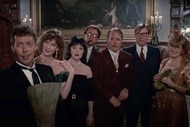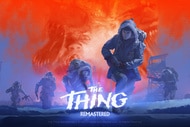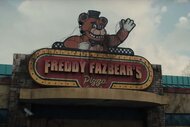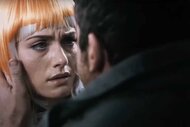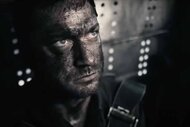Create a free profile to get unlimited access to exclusive videos, sweepstakes, and more!
Tom Clancy's The Division 2 can't ignore its political implications

Massive Entertainment, Red Storm Entertainment, and Ubisoft, the creators of Tom Clancy's The Division 2, insist their game isn't political. In an interview with Polygon prior to its launch, Red Storm's creative director Terry Spier called the release, which sees players cast as government paramilitaries working to restore control in Washington after an ecoterrorist releases a deadly virus, a story simply about making sure "the nation does not collapse" that is "definitely not making any political statements."
This has been hard to credit, given both the game's premise and an ad campaign that's included bad jokes riffing on the American government shutdown earlier this year and the campaign for an U.S.-Mexico border wall. Much has been written about the baffling insistence that the game, in light of its plot and advertising, could be as apolitical as Spier claims prior to its release. But marketing is its own extension of the multi-million dollar process of making a video game that, often enough, has very little correlation with the experience of playing itself.
Now that The Division 2 is out, and I've spent 30 hours shooting through its dilapidated rendition of the American capitol, it's possible to see both its creators' intent to obfuscate any identifiable political statement and the absurdity of the notion that a truly "apolitical" game is possible to create.
A short video that plays after The Division 2's prologue establishes this from the very beginning. Over footage summing up the events of the first game (the virus is released; Manhattan falls into chaos; sleeper government agents from "The Division" are activated to kill bandits and restore order), a narrator explains how ill-prepared the nation was for a calamity of the plot's scale. "Did you own a gun? Did your neighbor?" it asks before segueing into a cursory look at how post-apocalyptic America divided itself into those who tried to rebuild communities and the ruthless "hyenas" who preyed on anyone weaker than themselves.
Soon after, the agent fights across the White House's South Lawn, ducking behind the wreckage of abandoned cars and industrial wreckage to shoot down the bandits in her way. Once inside, the building under government control once more, missions are given to clear the rest of the city of hostile forces, their enemy status predicated on the sort of exaggerated brutality defined by executing civilians en masse. Over the following dozens of hours, the player unquestioningly carries out this task. She is a well-armed answer to the opening's paranoid, Second Amendment-reaffirming question, healing the community by killing any that might threaten it.
Within The Division 2's first hour, the game has established its outlook: the world is a barbaric place where order is maintained at the barrel of a gun. Using D.C. as a dramatic backdrop, it works as a send-up of violent diplomacy and the innate righteousness of plucky, patriotic Americans fighting for the integrity of their nation's political structure.
Trying to ignore this viewpoint is only possible if the player's willing to shut out everything about the game's setting and plot. The Division 2 mostly involves traveling from one neighborhood to another, heading to side missions and activities that involve annihilating enemies so their resources — water, technology, food — can be diverted to government-sanctioned survivor camps.
All of this plays out the same way: by herself or with a squad of other online players, the player clears the urban battlefields of enemies by shooting them down, listens to a radio call outlining the objectives at hand, collects new equipment, heads back to home base to sort through these new items, and then repeats the same steps again and again. There's a narcotic lull encouraged by this repetition. The character moves nimbly in and out of cover, the various rifles, shotguns, and pistols feel good to shoot, and equipping new gear and watching stat-tracking numbers climb higher is satisfying on a basic, lizard-brain level.
Sedated and content, the game doesn't encourage engagement with its plot points or visuals. At one point, the player fights through a museum exhibition detailing the Vietnam War, posters highlighting the stateside protest movement. Any question naturally raised here about the role of misguided martial patriotism and the contemporary social revolution that aimed to rethink American governance is ignored in favor of the more immediate concerns of shooting enemies and proceeding to the next map marker.
As with the rest of The Division 2, all context is rendered down into something mush-brained and reflexive, no time for greater commentary to emerge among the insistent loop of killing and trying not to be killed in turn. The score — hazy synths and pounding drums in combat — keeps the player moving forward, always looking toward what firefight, new gear, or experience points are to be dealt with next rather than providing time to think about what the game is saying in the first place.
This is what an "apolitical video game" looks like — a blur of aesthetic references and scant plot points so watery and insubstantial its messages seem too slippery to accurately pin down. Still, as much as The Division 2 encourages its player to forget the narrative and relax into the automatic pleasures of its repetitive combat and character-building systems, it's impossible to completely divorce it of its political viewpoint.
Sometimes this is the result of a major plot point. After rescuing the president partway through the story, for instance, we watch him take a seat in the shabbily rebuilt White House and tell the Division agents that they should do whatever's necessary to restore order, regardless of the human cost. He reminds them their actions may not be popular, but he's less interested in "wooing voters" than "getting s*** done." Played completely straight, the game suggests that the ends justify the means, no matter how violent those ends may be. It's an extension of The Division 2's general philosophy of might making right — of the American flag providing validation for any sort of vigilante justice.
Less explicitly, the game sees the agent return to bases where community members have set up gardens and recreation centers between missions. In these temporarily peaceful hubs, the local population praises the agent for doing what it takes to get them the resources necessary to build their new pockets of American society. Through individualist violence, positive growth can occur. The message seems simple: kill the right people thoroughly enough and peace is possible.
Countless other examples, from a hilariously goofy mission to steal the Declaration of Independence back from the nasty (also local) bandits who've taken it to the basic endorsement of violent resource acquisition inherent to the game's Diablo-style equipment upgrade system, all work to refute the idea that The Division 2 can be reasonably read as avoiding the "political statements" its creators ensure it lacks. While the game does its level best to minimize, obscure, and confuse what it's trying to say, its worldview emerges regardless.


